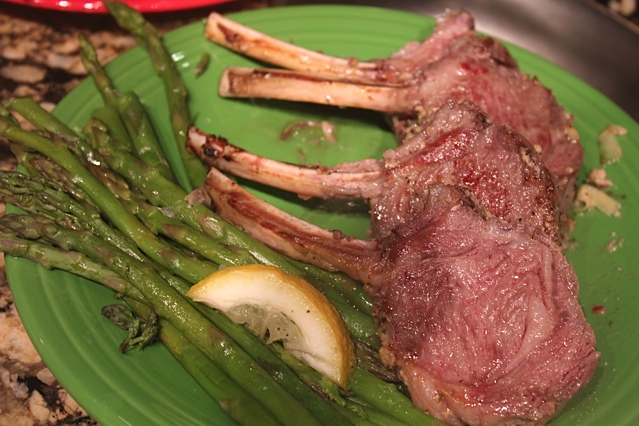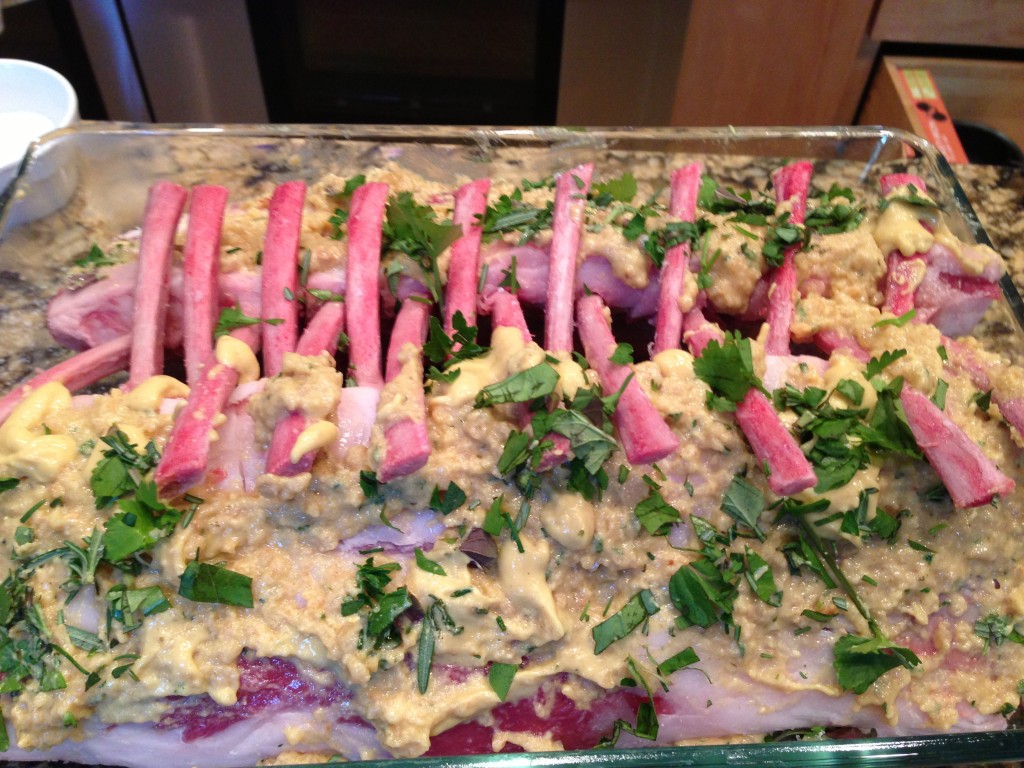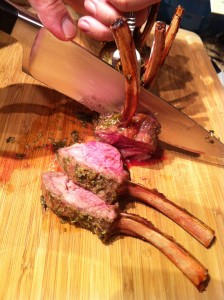
Lets just start out by saying that this meal is probably one of my favorite meals of all time. Total calories in this meal < 300 calories again.
To start with you need to have great product, and great product for lamb starts in one place from Elysian Farms. Here is what the lamb looked like when we started with our preparation:

We seasoned the lamb with salt then added Dijon mustard, minced garlic, and fresh herbs from the garden. Here a bit of mint with some rosemary
Rack of lamb is one of the easiest meals to make and is quite luxurious. Once you are done with this Big meal, with small calories- you will feel full for hours. For a recipe try here.
The asparagus is simply made by mixing olive oil with Montreal Steak Seasoning in a bag, and placing in the oven for the last ten minutes that the lamb is in the oven.

I like them medium rare to rare
Eat Big but Small is an experiment to increase the quantity of food that is nutrient dense, but calorie light. It is not an experiment to be “fat free” or “sugar free” – it is simply an experiment to see how a person would do when we follow some simple rules of biology. Those rules are:
(a) Your stomach, and your brain, respond to volume.
(b) The appetite suppressive signals to the brain are in a bit of fat as well as protein
(c) Most people never eat the quantity of vegetables that they should
(d) Anorexia is not an option for weight loss
(e) You want to have a visually appealing plate of food
(f) You want to eat slowly to give your body a chance to enjoy the food, and when you are finished there will be the lowest level of appetite hormone circulating
It is simple- it easy easy – and one does not every feel as if they are going to deny themselves.
Plus, you can eat like an Alaskan with this meal – pick up the lamb bone and enjoy munching on it.
The first question:
I ate this over 30 minutes. It was a flavorful lamb, with a perfect balance of the sweetness of the asparagus with the bitter and sour notes from the lemon over the vegetable. The mustard and the crispy crunch of the lamb coating gave my tongue a delicious texture and flavor combination.
I was finished and was not hungry – in fact my stomach felt quite “full.” I was up late that night, later than usual, and five hours after dinner I still felt quite satisfied.
The next morning, awaking at 5 am, I did not feel the first pangs of hunger until five hours later at 10 am.
For those interested in calorie count- you may have done this by now, but there are less than 300 calories in the entire meal.
Try it – here is the science behind the principles:
The stomach received a lot of volume, mostly from the vegetables. Stretch in the stomach is one of the main factors to suppress appetite. It is the volume stretch behind the food as it leaves the esophagus in the first part of the stomach. This is where the Lap-Band works.
The fat in the meal came from the olive oil with the asparagus and the lamb.
This gave me a lot of vegetables, and they were quite enjoyable, I ate more asparagus than on this plate- in fact, I recommend you eat a lot.
Eating less is anorexia, and while it works on some diets for a bit it leaves people hungry, and in some cases -rather nasty temperament.
The visual appeal of the food is there- it looked stunning on a plate, and it was a regular size plate, I didn’t fool myself into using a salad plate.
Eating it slowly, and with the small bites – I really enjoyed the lamb- the many flavors and tender texture.
Finally it was a nutrient rich food. I don’t wish to deny my body nutrients- the lamb and asparagus have many bio-available bits of nutrition.
Hours after eating the meal – I was not hungry – from that night, through the next morning.
Let me know what you think- and try this. By the way, for my Lap-Band patients, this would be considered an appropriate meal. And here I am, without a Lap-Band, and I didn’t feel the need to eat more.
